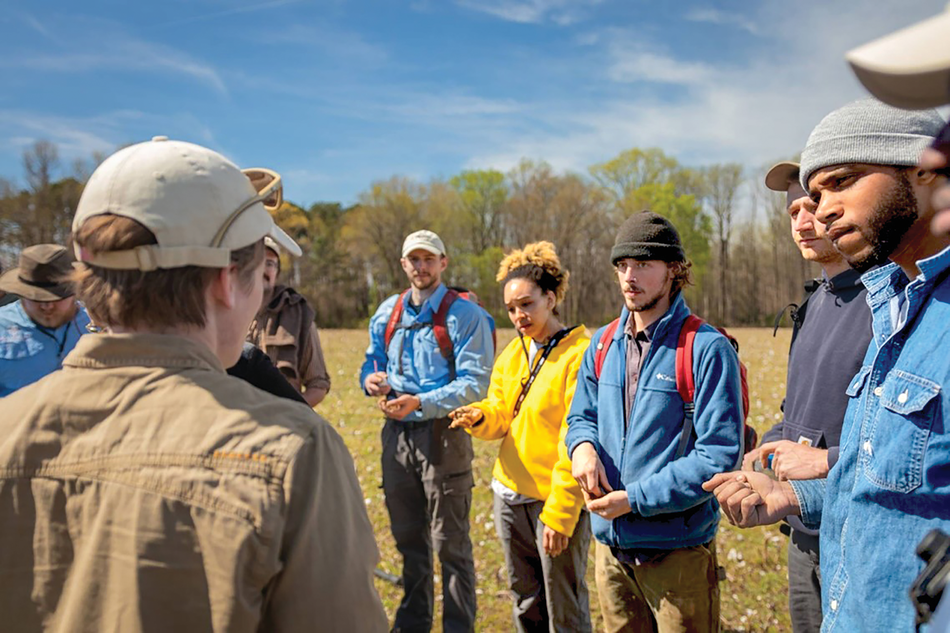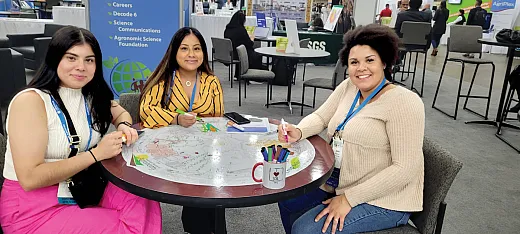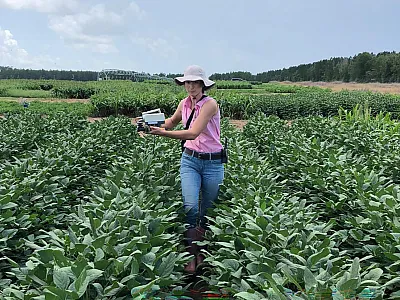Comparing Notes: Lessons Learned From Six Early Career Members

This article started as a phone conversation between two friends. As we compared our experiences as Society members on that call, we started to wonder whether others had similar stories. Before long, the call morphed into a video meeting with six people connected by their time in graduate school at one university discussing their experiences with the Societies. The group consisted of two men and four women ranging in age from 25 to 44 who had been Society members between 4 and 12 years. Each came from varied backgrounds with expertise in soil mineralogy, biogeochemistry, soil chemistry, astromaterials research, permafrost research, soil microbiology, soil physics, and aerospace and agricultural engineering. Two participants were research scientists at non‐profits, two were postdoctoral researchers with government labs or affiliates, one was a doctoral candidate, and one was working in watershed extension at a university. However, all were less than seven years from their terminal degree, meaning they were all considered to be early career members. This meeting was recorded, and we used the transcript to identify themes from the conversation that might provide insight into the early career experience for CSA News magazine readers, especially students and early career members.
While it is likely that our readers are all Society members, we all come to the table with different levels of understanding, so we want to start by providing context. When we say the “Societies,” we are referring to three international scientific and professional societies: the American Society of Agronomy (ASA), the Crop Science Society of America (CSSA), and the Soil Science Society of America (SSSA). Because of their common goals, these three Societies have a cooperative relationship. Each organization is autonomous with its own bylaws and governing boards of directors. The Agronomic Science Foundation supports ASA, CSSA, and SSSA activities, programs, and projects. Another entity to be aware of is the Alliance of Crop, Soil, and Environmental Science Societies (ACSESS), which is a nonprofit 501(c)(3) organization providing management and administrative support services to the Societies.
While there are differences between them, all three Societies support their members and certified professionals in numerous ways such as by providing quality research‐based publications, educational programs, certifications, science policy initiatives, and meetings. The International Annual Meeting offers a chance for leading scientists, researchers, educators, policymakers, students, exhibitors, and government institutions to gather to discuss cutting‐edge developments in agronomy, crop science, and soil science and features groundbreaking research. The meeting includes scientific sessions, workshops, poster sessions, an exhibit hall, and student‐focused programming. Our group valued the Annual Meeting but also listed other impactful benefits of Society membership, such as:
- Connecting and collaborating with other scientists
- Volunteer opportunities
- Leadership opportunities in a safe learning environment
- Understanding how large organizations function
- Webinars and other educational content
To provide these benefits (and the many others that our group didn’t list), the Society charges annual membership dues (see agronomy.org/files/membership/23‐asacssasssacosts.pdf). One of the most visible benefits of Society membership, the Annual Meeting, has associated registration costs. Registration for the meeting in 2023 costs $605 for professional members, $495 for early career members, $300 for graduate student members, $300 for emeritus members, and $90 for undergraduate student members (SASES).
Travel and lodging must also be considered in this cost, which varies from year to year depending on the host city. Some participants are able to receive scholarships or travel awards to reduce the cost through the Societies or other organizations.
Now that we have that context, let’s get back to our panel discussion about early career Society membership. Our conversation uncovered three thematic areas that may be useful to our readers. These themes were (1) early career members face common challenges to active membership, (2) feeling connected is a driving force to participation but takes time and effort, and (3) the reason you join the Societies may not be the reason you stay. The first theme is focused on barriers to active membership, and the last two hold potential solutions to getting involved. Let’s talk a bit about each of these themes and share details and strategies that our group discussed.
(1) Early Career Members Face Common Challenges to Active Membership
If you are a member of the Societies, have you thought about not renewing your membership? Each panelist on the Zoom call had considered letting their membership expire at one time or another. Some of the challenges to active membership that our panel identified included:
- Career moving away from soil/crop/agronomic science
- Not seeing myself as part of this community/identity
- Not having research to present at the Annual Meeting
- Struggling with the busy environment at the Annual Meeting
- Discouraged by failed attempts to connect with someone

Several people described times when they felt their work wasn’t relevant to the Societies. Almost everyone on the call reported that at times they felt their work didn’t “fit in.” Others had periods where the cost of membership and/or the Annual Meeting seemed greater than the potential benefits. It takes time to engage in the Annual Meeting and more time to be engaged in events like running for office, voting, planning the annual program, and serving on committees. The Societies are also so large that they can be overwhelming—both the meetings and the structure of the organization. This can be a particular issue for neurodivergent individuals who don’t enjoy crowded or chaotic environments. Lastly, several of us were discouraged after failed attempts at contacting someone in the Societies. When reaching out to one or more people and trying to get plugged in, there was little to no response or assistance. These challenges are real and common, but our group also had some strategies to address them.
(2) Feeling Connected Is a Driving Force to Participation, But Takes Time and Effort
Plugging in as an active member can be smoother if you expect that it will take time and effort. Not everyone you contact may be responsive or enthusiastic at first. One reason for this is that many of these people are volunteers. While ACSESS staff are employees, all other organizers, leaders, and board members are unpaid. Just like you, they have full‐time jobs, families, and community commitments besides their Society roles. Another challenge to expect is turnover. Roles will change from year to year, so you may be working with new people each year if you continue a particular activity. This is built into the system so that volunteers aren’t burdened with long‐term responsibilities.
Nobody can know everyone, so you will want to find a subset of Society members who you get to know and can develop relationships with. Keep trying to plug in even if some interactions don’t go as planned. Several panelists had success after trying out several different sections/divisions/communities and now have a professional “home” in an area different from what they did in their graduate research. A few of us found that attending a smaller Societies’ meeting was a good way to connect with people in a way that would be challenging at the Annual Meeting. If you are having trouble feeling plugged in, another strategy that came up was to consider voicing what your challenge is. No group is perfect, but the Societies are making an effort to study and invest in diversity, equity, and inclusion. At least one person in our group felt encouraged after voicing to colleagues that typical meeting activities were difficult for their engagement style.
Lastly, all of the members on our panel said the main reason they were still members was because of a personal connection—either a mentor or colleague who encouraged them to be involved. If you don’t have a relationship like that yet, it’s not too late! A clear theme among our group was that we didn’t really feel connected until we started to volunteer. So, whether it is a committee you volunteer for, an office you run for, or a session you help organize, roll up your sleeves and get in there because a sense of belonging most often gets built from working side by side with your colleagues. Following are some tips for getting actively involved in ASA, CSSA, and SSSA:
- Volunteer by joining a committee, becoming a reviewer for a journal, or mentoring students
- Find a mentor
- Participate in sections/divisions/communities that aren’t your research area
- Attend a smaller Society meeting (e.g., Kirkham Conferences or chapter/branch meetings)
- Identify a subset of Society members to develop relationships with
- Be persistent
(3) The Reason You Join the Societies May Not Be the Reason You Stay
Everyone in our discussion became a Society member as a student. We all felt that there was an expectation to be involved in the Societies, primarily with the purpose of presenting our research at the Annual Meeting. However, our reasons for membership now go beyond that (see some examples above). Several of us said that the main benefit of continued membership was networking. This led to the recommendation that members attend meetings even when they can’t present work. One person said that their reason for attending the Annual Meeting had shifted from direct personal benefit to mentoring people that they supervise. They found that the Annual Meeting is a great opportunity for professional development and wanted to introduce others to this resource.
Another driver for current membership was to demonstrate professional leadership. Several of us noted that being involved in planning the Annual Meeting or contributing to Society leadership was carrying on the tradition of the academic or workplace community to which we belong. And, maybe most important of all, several of us uncovered an unexpected passion when exposed to the wide range of expertise in the Societies. One member found a passion for congressional advocacy for science through the Congressional Visits Day program.
We hope that this discussion may be helpful for you as you consider the value of your Society membership and think about how you might get involved. See the box on this page for a few resources that might help you dig in a bit more. We hope to see many of you in St. Louis for the 2023 Annual Meeting or work with you in other ways as we pursue our work and interests in soils, crops, and agronomy!
RESOURCES
Early career resources: agronomy.org/membership/early‐career ACS committee opportunities: soils.org/membership/committees. Membership benefits: agronomy.org/membership/become‐a‐member, crops.org/membership/become‐a‐member, and soils.org/membership/become‐a‐member International Annual Meeting: acsmeetings.org
Text © . The authors. CC BY-NC-ND 4.0. Except where otherwise noted, images are subject to copyright. Any reuse without express permission from the copyright owner is prohibited.











